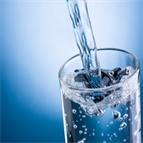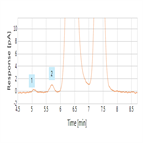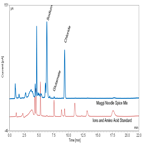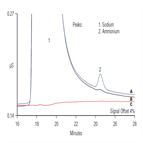Find methods for your needs
Refine by Feature
Displaying 1-5 of 9 results for Tag: ion
EPA Method 557 - Analysis of Haloacetic Acids, Dalapon, and Bromate in Drinking Water by IC-MS/MS
Instrument Type: ICMSHaloacetic acids (HAAs) are formed as disinfection byproducts when water is chlorinated to kill bacteria. Chlorine reacts with naturally occurring organic and inorganic matter in the water, such as decaying vegetation, to produce disinfection by-products (DBPs) that include HAAs. Of the nine species of HAAs, five are currently regulated by the U.S. Environmental Protection Agency (EPA). We demonstrate a simple and sensitive IC-MS/MS method for analyzing haloacetic acids, the pesticide dalapon, and bromate in water using EPA Method 557.
Analysis of Mannose-6-Phosphate by HILIC-CAD
Instrument Type: HPLC-CADA method for the purity analysis of mannose-6-phosphate using an isocratic HILIC elution is described capturing free phosphate, a related impurity, and the sodium ion using the Acclaim Trinity P2 column and the Corona Veo detector. A high injection volume (40 µL) was used on a sample of 1 mg/mL of mannose-6-phosphate to show the free phosphate. A higher concentration and lower injection volume can also be used.
2D Analysis of Protein Therapeutics and Amino Acid Excipients
Instrument Type: HPLC-CADTherapeutic proteins (antibodies and vaccines) vary considerably due to the nature and dose of the protein molecule. Aggregation is a major degradation pathway of protein therapeutics during storage. Stabilization of these protein formulations can be enhanced through the addition of specific excipients such as surfactants, amino acids and sugars. The separation of therapeutic protein and amino acid excipients was performed using a 2D approach. An integrated UHPLC system with a UV and universal charged aerosol detection offering multi-mode detection for the simultaneous analysis of both non-chr
Simultaneous analysis of sodium and glutamate in food products.
Instrument Type: HPLC-CADA gradient HPLC method was developed for the direct analysis of sodium and glutamate present in a popular food product from India called Maggi 2-Minute Noodles. Chromatographic separation was performed using the mixed mode Acclaim Trinity P1 column. One advantage in using this multi-modal column is that several ions such as sodium and chloride can be simultaneously measured along with glutamate present in the Maggi spice mixture. A simple direct method for the analysis of various amino acids is possible using the universal charged aerosol detector (CAD) as previously published.
AN1073: Determination of Ammonia in Sodium Bicarbonate
Instrument Type: ICThis study describes an ion chromatography (IC)-based method for the determination of ammonia (as ammonium) in sodium bicarbonate. The method performance characteristics—linearity, precision, accuracy, ruggedness, and the limits of detection (LODs) and quantitation (LOQs)—were measured according to the requirements described in the USP General Chapter <1225> guidelines. The automation features such as the electrolytically generated mobile phase and self-regenerating suppressor contribute to the robustness and sensitivity of this method.





